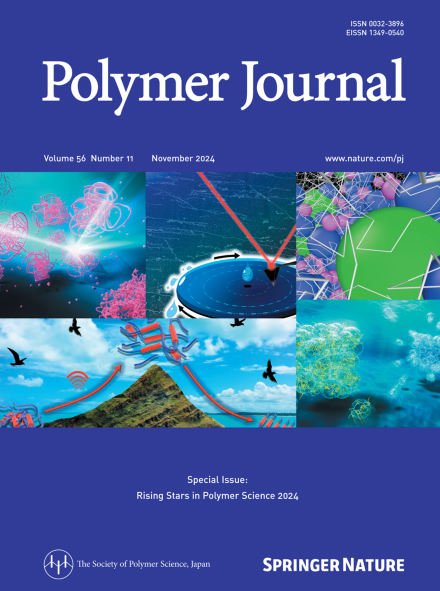胺改性有机硅反应熔融捏合提高聚乳酸/淀粉乙酸酯的韧性和相容性
IF 2.3
4区 化学
Q3 POLYMER SCIENCE
引用次数: 0
摘要
不可生物降解塑料污染因其对生态系统的负面影响而成为人们关注的焦点,聚乳酸/淀粉共混物作为一种生物降解塑料,作为可持续材料越来越受到人们的关注。然而,疏水聚乳酸与亲水性淀粉的相容性较差,导致其复合材料变脆。为了改善PLA与淀粉的相容性,本研究采用乙酰乙酸酯对淀粉的羟基进行改性,并采用胺改性有机硅作为相容剂。乙酰乙酰基在温和的条件下容易与伯胺反应生成胺,在熔融捏合过程中有望迅速反应。氨基也通过缩合反应与分解的聚乳酸端基发生反应。因此,胺改性有机硅被认为是PLA和淀粉醋酸酯(SAA)的合适增容剂。采用熔融捏合法制备了PLA/SAA/胺改性有机硅共混物。添加3 wt%胺改性有机硅后,PLA/SAA的韧性提高了约15倍。此外,在拉伸断口的SEM观察中发现,SAA在PLA中的分散性得到了改善,SAA和PLA无法区分。这种方法有助于在包装材料和一次性塑料中广泛使用生物可降解塑料。为了提高PLA与淀粉的相容性,本研究采用乙酰乙酸对淀粉的羟基进行改性,并采用胺改性的有机硅作为相容剂。采用熔融捏合法制备了PLA/SAA/胺改性有机硅共混物。添加3 wt%胺改性有机硅后,PLA/SAA的韧性提高了约15倍。这种方法有助于在包装材料和一次性塑料中广泛使用生物可降解塑料。本文章由计算机程序翻译,如有差异,请以英文原文为准。

Improvement in the toughness and compatibility of poly(lactic acid)/starch acetoacetate through reactive melt-kneading with amine-modified silicone
Nonbiodegradable plastic pollution has taken centerstage because of its negative impacts on ecosystems, and poly(lactic acid) (PLA)/starch blends, which are biodegradable plastics, have attracted increased attention as sustainable materials. However, the poor compatibility between hydrophobic PLA and hydrophilic starch causes their composites to become brittle. In this study, to improve the compatibility between PLA and starch, the hydroxyl groups of starch were modified with acetoacetate, and amine-modified silicone was used as the compatibilizer. The acetoacetyl group readily reacts with primary amines under mild conditions to form enamines and is expected to react rapidly during the melt-kneading process. The amino groups also react with the decomposed PLA end groups via condensation. Therefore, amine-modified silicone is considered a suitable compatibilizer for PLA and starch acetoacetate (SAA). PLA/SAA/amine-modified silicone blends were prepared via melt-kneading. The toughness of PLA/SAA was improved by approximately 15 times when 3 wt% amine-modified silicone was added. Furthermore, in the SEM observation of the tensile fracture surface, it was found that the dispersibility of SAA in PLA was improved such that SAA and PLA were indistinguishable. This approach can contribute to the widespread use of biodegradable plastics in packaging materials and single-use plastics. In this study, to improve the compatibility of PLA and starch, the hydroxyl groups of the starch were modified with acetoacetic acid, and amine-modified silicone was used as a compatibilizer. PLA/SAA/amine-modified silicone blends were prepared by melt-kneading. The toughness of PLA/SAA was improved by about 15 times by adding 3 wt% amine-modified silicone. This approach can contribute to the widespread use of biodegradable plastics in packaging materials and single-use plastics.
求助全文
通过发布文献求助,成功后即可免费获取论文全文。
去求助
来源期刊

Polymer Journal
化学-高分子科学
CiteScore
5.60
自引率
7.10%
发文量
131
审稿时长
2.5 months
期刊介绍:
Polymer Journal promotes research from all aspects of polymer science from anywhere in the world and aims to provide an integrated platform for scientific communication that assists the advancement of polymer science and related fields. The journal publishes Original Articles, Notes, Short Communications and Reviews.
Subject areas and topics of particular interest within the journal''s scope include, but are not limited to, those listed below:
Polymer synthesis and reactions
Polymer structures
Physical properties of polymers
Polymer surface and interfaces
Functional polymers
Supramolecular polymers
Self-assembled materials
Biopolymers and bio-related polymer materials
Polymer engineering.
 求助内容:
求助内容: 应助结果提醒方式:
应助结果提醒方式:


